Leaderboard
Popular Content
Showing content with the highest reputation on 01/25/2021 in all areas
-
Top 10 common mistakes newbies make when starting up a marine tank. People study other people’s past so they won’t make the same mistake, that is why we call it his story. (Get the puns?… ok fine sorry). Anyway here are the TOP 10 mistakes newbies make when starting up a marine tank. Number 10: Jumping into the hobby without research. When people start to get interested in the hobby, some people tend to try to save money on the equipment they use and at the same time, they don’t do any research on what they are buying. Of course, a piece of better quality equipment will definitely be more pricey than a cheaper one. For example, using a cooling fan to chill off the aquarium instead of running a more expensive chiller not knowing that it actually cause issues such as accelerated evaporation and sudden change in salinity which actually cause more work to maintain those level. And due to this, they might actually end up upgrading their equipment and spending more to getting a chiller later on. Another example for which some people tend to buy fishes or corals without learning their compatibility and care level and finding out later that they cannot take care of it well eventually causing livestock suffering or even death. Which finally, they might find themselves giving up on the hobby or they will finally decide to do some research to learn about it. (We have a SRC forum for you to do your research on!) Be a responsible reef keeper and know what you are buying and able to care for it before your next purchase! A refractometer is a more common means of salinity measurement in the hobby Another example is the wrong equipment choice (could be a budget-related concern ) but might find himself ended up with terrible equipment choices not suitable for his/her tank system. For Example, getting a cheaper Swing arm hydrometer comparing to a refractometer to measure salinity which is less accurate. Or buying an optical refractometer from online shops without first checking and knowing that it is not meant for other purposes rather than for the saltwater aquarium (eg for beer-making) . To summaries, selection of equipment base on suitability is more important than solely on prices alone only. Picture showing tank cycling process. Number 9: Skipping the cycling process / Adding livestock before cycling process is complete Very understandable – we are all anxious to see our new tanks come to life when we get our new marine tank setup . Well, it is a mistake that was even made by me in the past. We tend to think after spending hundreds of dollars on equipment, it definitely makes keeping marine life easier. WRONG. Tank Cycling is still a must regardless of how much a product says it can cut off its cycling time. So what can we do to know cycling is done? With water testing, we can be able to test our water to see if the tank cycling process has been completed anot. In that case when ammonia ( NH4) and nitrite (N02) is zero. Your tank is ready to introduce your first guest into your new tank! Number 8: Not doing water change. Water change is tiring and it could be a huge hassle for some, however as time goes by, nutrients in your tank will build up and elements like calcium, magnesium, trace element and etc will deplete too. The best way to maintain your tank is doing a regular partial water change. Not only do you reduce the nutrient, you also replenish the element that is depleted in the system. You still need to test your water and top up elements that are low. Number 7: Adding more fishes than your system can handle Well if you google it will show the Rule of Thumb which means The short “Rule of Thumb” answer generally accepted in the marine aquarium hobby is: “One inch of fish (measured from the nose to the base of the tail) per 5 gallons (20L) of system saltwater. However, it also depends on the species of your fishes and how big is your tank is. Don’t be afraid to always post online to ask about the care level of that particular fish. As for this article, I’ll recommend to always monitor your ammonia and Nitrite level ( Which is toxic to fish ) as well as your nutrient level ( Mainly Nitrate & Phosphate ). Number 6: Cleaning the sand bed. Having Sandbed in a reef tank is a beautiful addition in a marine tank, however, if you decided to have a sandbed but not taking care of it could actually cause more harm than good. For a shallow sandbed, it is advisable to do some vacuuming to remove any debris or leftover fish food on the sand surface to prevent any debris from building up. However, if you have a deep sand bed ( DSB ) , it might not be a good thing to stir the sand bed to prevent any disruption to the biological filtration function of it. Alternatively, it is good to have some cleaning crew like the tiger nassarius snails, and sand shifting star etc to helps keep the sandbed clean… Number 5: Not acclimating newly bought livestock into tank. If you ever bought healthy livestock and decided to throw it in the tank thinking everything will be ok, you could be wrong. There could be a great variant of water parameter and temperature differences between the water at the live fish shop store and your tank. The sudden shift in water parameter if you did not acclimatize your newly bought fish/coral correctly will stress the corals which could result in the death of the newly purchased livestock. Acclimating simple mean adjusting the water parameter for example temperature, PH, and salinity etc of the water between the new and the old to avoid any sudden shift. This should be done in a slow manner to allow the new fish to adapt to the new water parameter without causing any stress to the new livestock. Be sure to check on the fish compatibility before the introduction of the new livestock, and check out on our detail fish acclimating guide. Photo showing fishes in an LFS (ABA) that are going through quarantine or medical treatment process. Number 6: Adding fish without proper quarantine. Quarantine simply means to isolate all new livestock that has arrived from another location that may have been exposed to infectious or contagious disease/parasites, before introducing it into the current system to prevent any form of diseases spreading to existing healthy fishes in the system. The quarantine period is typically 2-4 weeks to observe if the newly purchased fish shows any signs of illness or disease and make any treatment if necessary in an isolated tank before introducing it into the main display tank. You can read about setting up a simple Quarantine system here Fish might appear to be well-fed and actively swimming in a fish shop. Even though it went through quarantine in the fish shop, it is surely a good practice to do our own diligence to do our own quarantine as well to prevent any chance of diseases introduction into our existing system. With a proper quarantine system in place, you will not risk risking your existing healthy livestock when you are adding any new fish or corals. Coral are going through dipping to remove unwanted pests. Number 7: Not dipping your newly bought corals. If you think that you are ONLY adding your new coral into your new system every time you purchase a new coral. You might be WRONG, hitchhiker like coral Pest could be hidden inside your coral without you knowing it, and these hitchhikers could be invisible to our naked eye. These coral pests could also be buried inside the rock that came with it, and the only way you can actually stop them from introducing into your tank is to perform a coral dip. After performing a corals dip, you will reduce the risk of introducing any form of the coral pest into your system that could have devasting effects. Number 8: Adding salt directly into your tank without mixing or testing. Well well, if you happen to make this mistake, that’s something to learn from. Introducing salt directly to an established tank system which might contain an undissolved component which not only giving you a false salinity reading but might cause other sudden parameter shift as well ( Example, sudden calcium, KH, increase ). Not only that, you might unintentionally raise more salinity, than needed without testing the salinity in the first place. The sudden increase in salinity could have a serious effect on the livestock in your system. So be sure to always mix it separately in a pail first, and testing the salinity after all salt is fully dissolved before trying to increase the salinity of your existing system. Number 9: Not performing regular water testing on your water parameter. Wow, my corals are so beautifully open and fishes are eating aggressively (too hungry?) Joke aside. Doesn’t it really mean that everything in the tank is good? If you decided not to perform your regular water parameter testing regularly and dosing and topping up the elements blindly, you might actually find yourself overdosing certain elements and causing harm to your livestock then actually helping it. Without performing a regular water testing, you will not be able to tell and replenish any loss or drop of the element to the optimal level for a thriving reef tank to be healthy. Take my advice and schedule to do a regular test . Let us have a beautiful marine tank. Tangs are aggressive territorial fishes and are to introduce together. Number 10: Adding fishes without doing a properly research I believe many new reefers has suffered this mistake of happily buying a beautiful fish during one of the trips to a local LFS before making any research or asking the store owner about its care requirement. Which for an example is the bicolour dottyback. As beautiful it is like a royal gramma, however, due to the fish behaviour nature, once introduced into your tank, it’s aggressive nature may attack any smaller or weaker fish that comes to its path which causing it to die. What is next? New fish lose their appetite and die from stress? From broken fins to death? As previously mentioned, always Always ALWAYS research on the species before purchasing. Get the smaller to bigger fish so it won’t bully the bigger one when introducing the latter. And ya avoid buying a fish if you do not know it feeding requirement and behaviour. Thank you all for reading my articles. If you want more, hit the like button. If there are any more articles you want me to write about, comment down below! Author - @Willy Guccivera Yap2 points
-
I think you are right! Binders are mostly carbonhydrate, so they don't contribute to nitrate and phosphate in the water. However, I believe the presence of excessive available carbohydrates may have some impact on the bacteria population in the aquarium. In terms of the digestability of proteins and fats, that's another issue all together. Pellet quality is an area where more discuss should happen. Let's keep the discussion going! Fair point. When I write this I was thinking about the idea of feed conversion ratio. In a way this is more critical for reefes than fish farmers, because we need to deal with unconverted food. I think those are fine choices, just tedious. I used to feed my fishes with blended live clams before with good results. But like I said, tedious. It's also not easy to be consistent from batch to batch when it comes to chopping. Another thing is, I would only use live seafood to do this, they are less likely (I think) to have preservatives such as sodium tripolyphosphate. Thank you @VANAN and @Maipian80 for your encouragement!2 points
-
Avoid these fishes! YES, Avoid these fishes! Here today we will discuss the most popular fish in the trade to be avoided. Given the beautiful color or the fish or perhaps the cheap price, you should always research and prepare for it as the fishes listed might be difficult to keep or difficult to get it fed. One of the most sough after fish ( Achilles Tang ) which belong to Acanthurus family is very susceptible to ich and require good water quality and large swimming space Ich Magnet Tangs are one of the obvious ich magnets, by saying ich magnets means they are easily susceptible to ich. One of the genus to avoid are Acanthurus which consist of Powder Blue, Powder Brown, Powder Black and Archillis tang are the most common fish to be seen in trade and also most susceptible to disease in a Reef Tank. It is not totally impossible to keep this species however you are required to quarantine every single fish that enters your tank from the start and also prepare to dip anything that enters it too because this is to lower the risk of diseases entering your tank. However, it still doesn’t 100% eliminate the chance of this fish getting caught with ich or die. One way to ensure your fish to be healthy and resistant is to feed them well to build up their resistance and ensure fish is fully quarantined before introducing it to your marine tank. Do also take note of the existing tank mate in your system as if it is not properly introduced, they might be aggressive towards each other and being bullied by established fish in the system which might weaken their immune system making them susceptible to develop ich again. Tangs also required amber swimming space and it is only recommended for reefer with 3ft tank and above. Damselfish Affordable, elegant and beautiful as it seems to be, however so note that some of the damsel species are notoriously aggressive fishes to other tank mates, that will attack another tank mate once it is established. If you really like this species you should consider introducing it last (Which maybe seem impossible because we always want to add new stuff), or introduce a bigger size fish after it. Be sure to research on the behaviour of the damselfish that you will be getting to avoid any aggression. Damselfish might do well in a school in the ocean but however, in a small tank, they often chase and bully themself to death as victims of the bullied may find themself hiding and die from starvation. Copperband butterfly Even myself, I love the beautiful white and yellow colours and also the long peck. However, do note that this fish diet is only known to eat copepods and aiptasia. You can train them to eat Mysis shrimp but it will require a lot of patience for that. Impossible to keep? No. But it has really come to how much commitment you can keep this fish with some stroke of luck as well. Once you are able to obtain a healthy specimen, the chance of getting it to feed prepared food will be higher, and you will be rewarded with a beautiful specimen swimming in your tank. Dragonet (Mandarin fish ) Same as a copperband butterfly, their diets in the wild consist only of live copepods and pods that are small enough to enter their mouth. It should only be kept in an established tank with lots of critters for them to hunt in the while. If you keep in a small tank, train them to eat mysis in a small isolation before release or else they will just ignore the food as they are never going to try to nibble on it unless in a confined area. Weird huh. Fortunately, there are captive breed specimen that is ready train to feed prepared food even pellets as well! However, do prepare to pay a little bit more for these captive breed one. Bicolor Dottyback Small yet aggressive. Dottyback is one of the most common fishes in the marine trade that newbies tend to purchase because they look like Royal Gramma from finding nemo. This fish may look gentle and harmless but do not be deceived by its looks, as once settled, they are really really really aggressive in their own space and always tends to bully new tank mates to death. I would totally avoid this fish but then if you really like this fish, do consider introducing it as the last fish without its own kind/body shape with ample swimming space for it. Pygoplites diacanthus – Regal angelfish is consider one of the harder angel fish getting it to feed prepared food in an aquarium environment. Most eat sponge in the wild. Picky eater Angelfish Some angelfish are picky eaters and it could be challenging getting them to eat prepared food in the captive aquarium, as some of their natural diets in the wild usually consist of a wide variety of sponge. Some species not limited to are Regal Angelfish, Multibar Angelfish and Golden Angelfish are the few of the beautiful angelfish that are often reported hard getting them to eat in a captive environment, which often ends up being dead from starvation. I will only recommend to purchase them if they are eating pellet in a LFS or show sign of feeding . PS: Do find out what pellet brand it is eating and get them to mix with what you feeding with. Lastly, other than avoiding the fish, you should also learn about how to pick a healthy fish which I will write on it next time. If you have more fish you wish to bring to attention to avoid, do write on the comment below. Author - @Willy Guccivera Yap1 point
-
1 point
-
Hi, I have 3 small RBTA (abt 20cts size) to trade with a can of 100plus each. Self-collect @ bukit panjang. PM me if interested. Thanks. Sent from my Pixel 3 XL using Tapatalk1 point
-
1 point
-
Bro, good write-up but needs clarifying. You are right about binders not adding too much nutritional value , but not about adding nutrients to the water. Binders used in pellets are carbohydrates ( starch, sugar etc). Some of it can be metabolized by fish for energy. But you dont end up with nitrates and phopates due to thhesr binders. Nitrates from food usually comes from the protein content. About 65-70 percent of the protein in the food gets passed through the gills as Ammonia ( more than 50 percent) and in poop ( about 10 percent). This ammonia then breaks down into nitrates. Choose the food that offers the most nutritional value. But the best foods does not automatically translate into the least nitrates/phospates. Happy reefing !! Sent from Singapore Reef Club mobile app1 point
-
1 point
-
1 point
-
Feeding the Aquarium The top of the line water processing facilities will do little to clean up the rivers if the factories and farms dumps chemicals indiscriminately. It's much cheaper for a country to control these polluters compared to trying to undo the damage. Same logic goes for reef aquarium. It is easier and cheaper to ensure less pollution enter the aquarium, than to try to extract the pollution from the water. That's why, I believe limiting the pollution is the first step towards health reef environment. However, it is crucial to note, that nutrient and pollution are not one and the same. One can feed the aquarium a lot, and cause very little pollution; while someone else may be heavily polluting the aquarium with minimum feeding. It all depends on how the feeding is done. Who Needs Food in the Aquarium? I would like to categorize the feeding clients into 3 categories: 1. Those who chases down the food, such as fishes and invertebrates 2. Those who wait for food to come to them, such as coral and sponges 3. Those who don't really "eat" such as bacteria and algae In an properly cycled and matures system. The population of three groups don't fluctuate much. Therefore the feeding need is always there. The Chaser Fishes and some invertebrate goes after the food and extract them from water column. Their feeding is efficient, since they don't need the whole water volume to be flooded with food. In fact when some pellets are added into the feeding tube, the pellets are often wiped out before they drift very far. Feeding for this group is, by nature, rather targeted. It's also easily to evaluate how much food is consumed. If the food is left unconsumed, it starts to decompose under the effect of bacteria action. This process consums oxygen, release carbon dioxid and lowers pH. It also release nitrogenous and phosphourus compounds. A source of pollution. What's unseen is even more crucial. If a fish consume the whole pellet in one swallow. Does it mean none of the nutrient is leaked to the water? Unfortunately, this is not the case. The food consumed by fishes and invertebrates must first be digested. Undigested food will just get excreted, before they start to decompose in water. Take a look at the following ingredient of a pellet. The second on the list, derivatives of vegetable origin, is the second most abundant ingredient in the list. These are likely wheat or soy flours used as a binder in the pellet forming process, but these are also terrestrial ingredients. The fishes may experience difficulty at digesting these. What happen to these components if fishes cannot digest them? They gets excreted as fish poop, and the bacteria in the tank acts on those poop, and break them down into nitrtates and phsophates. It's almost as if part of this pellet is not consumed at all. Therefore picking a good pellet is critical not only to ensure fishes recieve suitable nutrients, but also minimize the impact of pollution. My definition of good is that majority of the ingredients should be marine origin, with as little binder as possible. Currently I'm using NewLife Spectrum pellets and TDO Chroma Boost. Recently, I came across Fauna Marin pellets. Interestingly, there is no terrestrial orgin ingredients in the food. I expect this food to be highly digestable. As the result, I expect the impact on free nutrient in the reef is minimal. I doubled my feeding amount, with the addition being the Fauna Marin Pellets. Just like how I predicted, there is no visible impact on the phosphate and nitrate concentration.1 point
-
1 point
-
1 point
-
Ups. Left with 2 head white tip green body yellowish mouth torch Sent from Singapore Reef Club mobile app1 point
-
Starting your first marine tank. Overview to plan your equipment and budget (Part 1) Starting a beautiful marine tank is exciting. But upon doing research online, the information may be overwhelming, contradicting & often confusing. This guide aims to provide a high level overview of areas to consider when embarking on the reefing journey. To help you make educated choices in planning & purchasing the right equipment. Most of the article will refer to a reef tank. General planning : What do you want to keep? The most popular set up is a reef tank – a mix of both fish & corals. And when it comes to corals, there are options of LPS (Large Polyp Stony Corals), SPS (Small Polyp Stony Corals) and softies. In general, LPS & softies are easier & less demanding than SPS. LPS are more tolerant of imperfect water conditions, require less flow & less light. On the other hand, SPS demand pristine water conditions, strong flow & very strong light. These affect your equipment choice. Left : Small Polyp Stony Coral (SPS), Right : Large Polyp Stony Coral (LPS) Another popular setup is a fish only system with no corals – commonly abbreviated as FOWLR (Fish Only With Live Rocks). For example, beautiful fish like Angelfish eat fleshy corals & nip on SPS are best kept in FOWLR systems. Less common is a species tank, where certain species have specific requirements. For example, seahorses are weak swimmers and require very low flow in the tank. They are compatible with most soft corals and gorgonians. You must avoid any stony corals that have a strong sting as this often leads to injury & infection. AIO (All in One) tanks. These are usually smaller setups ranging from 10L to 300L. The compartment to place small filtration equipment & bio media are at the back of the tank. AIO tanks are great for reefers with limited space or those starting out to learn the ropes. Display tank with sump (Recommended set up for marine tanks). A sump is an additional tank usually below the main display tank where equipment and additional filtration capabilities can be enabled. You can have proper mechanical filtration, large skimmer, more biological media and multiple media reactors. A sump allows easy access to the filter & equipment which makes maintenance easier which typically leads to a more successful tank. The dedicated cabinet helps hide the sump & clutter of containers & equipment For both the AIO and Tank/Sump options, you can choose from purchasing ready made system, or to have them custom designed. Ready made tanks have the necessary components included and are more straight forward to set up. Custom made tanks offer options such as tank size, glass type, overflow, piping & cabinet customization. Approach your local fish shop for further advice. Simple bare tanks (not recommended for a marine reef aquarium). There are some who covert their simple & bare freshwater tanks to saltwater. And attempt to re-use the tank by using canister filters or hang on back filters. Such setups are not recommended as the filtration is not adequate. Using an external canister filter is troublesome & will result in neglect & possible failure. On the other hand, a simple bare tank is adequate as a short term quarantine/hospital tank. Equipment Once you have decided on the tank type, start planning for some other equipment. Namely : Return pumps Return pumps move water from the sump or IOS compartment back to the main display section. The 2 main types are DC (Direct Current) & AC (Alternating Current) pumps. DC pumps allows adjustable pump speed but are more expensive than AC pumps. DC pumps are useful if you plan to T-off the return pump for reactors & chillers. As you add more equipment, you can adjust the pump speed accordingly. DC pumps. Example of how T-off piping to feed various reactors AC pumps have fixed speeds. You need to purchase the right size for your needs. Various sizes of AC pumps Turnover rate from sump to display tank of about 4x is sufficient. For example, for a 500L tank, a return pump speed of 2000l/hr (liters per hour) is sufficient. Note the advertised flow rate on the box depicts maximum flow of a pump (no pipe restrictions or height pressure losses). In a tank system, pipe restrictions (bends, elbows & valves) slow the flow rate down. A general rule of thumb is to assume it slows the pump flow rate by half. If you T-off the water flow (i.e. feed water to other equipment as well), then pick an even higher rated pump accordingly. With a DC pump, you can easily reduce the power & flow rate. Wavemakers & Flow Flow is important for a healthy reef tank to bring oxygen & food to the corals. Most popular wavemakers allow adjustable propeller speed & duration. The goal is to create pulses & random flow patterns in the tank, just like in the ocean. Size the wavemakers correctly for your tank size. Do not place them directly in front of corals as the continuous direct flow will damage coral tissue. Larger tanks will require more wavemakers for better coverage. Some higher end wavemakers have the motor outside the tank and magnetically coupled to the propeller/wet side inside the tank. This unique feature with 2 key advantages Motor heat is not absorbed by the water. Allows the wet side be removed easily for cleaning. Gyre pump blades Another popular design are gyre pumps which use a different style fan blade to produce wide laminar flows. You will need fewer wavamakers in a tank with these since they cover a wider flow width. The downside is these pumps tend to be more troublesome to clean Lights The 2 common light options are T5 & LEDs. T5 provide a blanket of diffused light to the entire tank so there is less shadowing of corals. You can configure it with different light tube types (colour temperature). While T5 fixtures have lower up front cost, the T5 tubes should be replaced every 9-12 months – they deteriorate & become less bright. ATI Sunpower T5 light fixture LED light fixtures are the more popular choice these days. While they may have slightly higher initial cost, a good LED set should last many years. LEDs are extremely efficient and can produce a lot of light and less heat compared to T5. You have the flexibility to tune the light to simulate sunrise, daylight & sunset. Or tune the spectrum based on personal preference or to the type of corals kept. Depending on the tank size, rock scape & type of corals kept, you may need multiple sets of LED fixtures to provide sufficient light energy for the corals to thrive – similar to the energy they receive from the sun. LED lights are typically mounted about 30cm from the water surface level. This should provide good light spread & not have hotspots (areas of concentrated light which can burn corals) PAR (Photosynthetically active radiation) is measure of the amount of light available for photosynthesis. Corals, clams & other animals originate from different depths of the ocean and have different PAR requirements. In general SPS need more PAR. Conversely LPS require less PAR. Having too strong light can also cause corals to bleach & die. Measuring the PAR levels using a PAR meter takes away the guess work of coral placement. Ask around the reefing community to loan or rent one. Lighting period The general guideline is to have about 6-8 hours of bright light for the corals to photosynthesize. It is common to have a few hours of bluish light at night to enjoy the beautiful glow of the corals. This is more of an individual preference. Below is an example of a light profile. Example of settings for Aqua Illumination Hydra lights Filtration There are 3 main types of filtration – Mechanical, Biological & Chemical. Mechanical filtration is the use of physical media or equipment to trap solid particles from the water. These are often placed in the 1st stage of the sump or IOS filter system to trap large particles before they clog the pores of biological filtration media. Key points : Filter wool comes in pre-cut sheets or long rolls Filter wool. Made of synthetic material. A cheap & convenient option. Use & discard Filter socks Filter sock. More elegant solution but more costly. Socks are made of nylon or felt. Nylon socks are easier to wash under the tap but has less filtering capacity compared to felt socks. Felt filter socks are quite inconvenient to flip & wash thoroughly. Sock pore size are typically in the 200-300 micron range. Clarisea SK 5000 Filter rollers. These automatic filters use a thin sheet of filter material (known as fleece) to capture dirt. A motor advances the filter material automatically when clogged. By removing food/dirt quickly from the water, filter rollers ensures minimal decay & contamination of the water. Fleece pore size are in the 25-50 micron range. A roll of fleece should last about 1.5-3 months Protein Skimmer is also another form of mechanical filtration. Often placed after the initial filter wool/sock/fleece. A skimmer uses a needle wheel pump to generate large amount of fine bubbles. This causes organic waste (fish food, fish waste & suspended particles) to stick to the surface of the bubbles which bursts when it reaches the top of skimmer. The splattered waste then flows into the collection cup. Having a good protein skimmer results in cleaner water & less frequent water changes. Protein skimmers have a secondary advantage of improving gas exchange & increasing the oxygen content of the water due to the bubbles it forms. Biological filtration refers to the use of bacteria in the tank to break down dangerous ammonia to less toxic nitrite & nitrates; commonly known as the nitrogen cycle. A term often mentioned in articles is ‘live rocks’ – this refers to a rock where bacteria reside. Current trend is to have minimal rocks in the display tank so that there is more space for corals & fish to swim, and the supplement with additional biological media (eg. ceramic balls, cylinder or blocks) in the IOS or sump to increase the surface area/population of this beneficial bacteria. Place loose media in a mesh bag or basket for easy removal for the occasional quick rinse with old tank water. Chemical filtration is a way to removed dissolved particulates using activated carbon, resins or other absorbent media. Resins for absorbing phosphates Activated carbon to remove toxins/clarify water. Measuring the right amount of media to place in a reactor. Chemical filtration media are best placed in a reactor to enable sufficient contact time between water & media for the reaction to take place. A less effective but acceptable alternative is to put the media in a mesh bag placed in a high flow area. Cooling Given the warm ambient temperatures here in Singapore, there is a need to cool the water to the 26-28 degree Celsius range. Cooling Fan. For those on a budget & smaller tanks, you can get away with a cooling fan blowing on the water surface. With this method, evaporation rates increase & you must have a good auto top up system to replenish the evaporated water quickly. Else, water parameters (eg salinity) will have big swings which is bad for livestock. TEC (Thermo Electric Chiller). An alternative for very small tanks (10-30L range) is a mini chiller using Peltier cooling technology. Such mini chillers are not very energy efficient (about 5% of electrical energy is used for cooling). They have a typical equipment life of 2-3 years. Chiller. A more energy efficient option is the refrigerant type chillers. Select one that is correctly sized for your tank. Electricity cost is not too high. One example of usage for a 1/4hp (~440 watts) chiller running 20min to chill. Turns on once every 3hrs to maintain a tank between 27-28degC. Based on rough calculation, this works out to SGD $0.21 per day. Or SGD $6.40 per month. For larger 4ft & larger tanks, it is common to use an non-invertor air con compressor with cooling coil. The compressor is best placed outside the house so the hot air goes is blown away. If this is not possible, it is also possible to place the compressor next to the aquarium. Compressors are extremely efficient & cools the tank fairly quickly. For example, a 4ft tank may take about 20min to cool and turns on once every 3 hours. 1HP non-invertor compressor unit & titanium drop in coil Auto Top off Water will naturally evaporate from the aquarium. Evaporation rates can be much higher when using a fan to cool the tank. As we are dealing with saltwater, only the water component evaporates (the salt remains). Salinity increases if no fresh water is added and leads to unstable water parameters. An Auto Top Off (ATO) is a device that detects the water level in the tank or sump. If it is too low, it then triggers a pump to top up fresh water from a reservoir back in. Take note the ATO should be using water only & not salt water (since only the water component evaporates) ….. to be continued in Part 2 Author - @SubzeroLT1 point
-
Why should we Dip corals? and how to perform it A colourful SSC Visiting a local Live Fish Shop (LFS) and shopping for corals is one of the best enjoyment in this hobby. However, do you know that if your newly purchased coral is not treated carefully, it could cause a serious effect on your existing healthy corals which is already thriving in your current marine aquarium system ? What is coral dipping ? As up to 90% of the corals in this hobby is either collected from the wild or cultured in the sea, there is a high possibility that the corals come with pest without the exporter or importer knowing it. The term coral pest simply means, invert or creature in the natural environment that hosts and eats coral polyps, coral zooxanthellae for its survival, and if left uncontrolled, it will keep reproducing itself which could cause a serious effect on all your corals in the tank. However, most of the time, it is hard to detect these hitchhikers , as due to their natural defence mechanism, that includes natural camouflage which makes spotting them extremely difficult with our human naked eyes. Photo credit; Leon tan Therefore, treating all new or infested corals with a coral dipping is one of the best remedies for this . Coral dipping simply means treating the coral with a commercially available solution that helps to remove those pests from the corals itself without harming the corals. However, do note that coral dip could be effective against the pest itself, but it can be useless against their eggs. How to perform a coral dip? To prevent any unwanted pests getting into your system and eating up all your existing prized corals, we should treat all newly purchased corals “ unsafe “ unless it has passed the quarantine period or safety period deemed by the hobbyist. Start with preparing two container filled with tank water and applying a moderate amount of coral dip solution in the dipping container and placing the corals into the container. Two container of water for dip and wash Dipping of corals in a prepared dip solution Follow the instruction of the coral dip products that you are using, and after performing the dip, transfer it to a newly prepared tank water ( Without the coral dip solution ) for a short bath before finally returning it to the tank. Some of the possible hitch hiker like this that can be found after the dip If any pest is found, do prepare to perform a second and a third dip a few days later as there might be eggs present that need to be redipped for any pest. Do not dip the same coral repeatedly as it might stress the corals and cause it to die from stress. Provide enough rest period for the coral to heal before performing a repeat coral dip again. Performing coral dip on mushroom corals However, if no sign of pests is present it might not mean that the newly purchased coral is 100% pest-free, as there might be eggs which are not visible to our naked eye or which has not been hatched during the coral dip that we have done. The dip will not be able to remove eggs, and it has to be done only manually. Which is also why It is strongly recommended to place all newly purchased corals into a separated quarantine system which a schedule dip can be performed over a period of up to 14 – 30 days which ensures that the coral entering the system will be 100% pest-free. If there are any eggs which are not hatched, it will hatch during this quarantine period, and the scheduled coral dip will remove them completely. SPS coral turning pale due to FW attack A infected colony that losses its color SPS with flatworm SPS infected with FW eggs So be prepared for every new coral, be it mariculture piece or coral frag big or small, there is every possibility of introducing a bad hitchhiker into your system which could cause a nightmare to you trying to figure out how to remove them later from your tank. A Possible schedule of a coral dipping process for all newly bought corals includes ; Day 1 – Coral dip and inspect visually for any sign of bite mark, pest, eggs on the corals itself or on the base of the rock that it comes with. ( Depending on the condition of the corals itself, if the coral look stress, or injure it is advisable to postpone this to further stress the coral ) Day 7 – A second coral dip to ensure that there is no coral pest observe during the dip Day 11 – Hitchhiker pests like AEFW ( Acro Eating Flatworm ) take about 11 to 14 days to hatch depending on the temperature, thus by the period this third dip is performed, the eggs would have hatched and dropped off from this third dipping. Day 14 – The purpose of this dip is to ensure that all unhatched eggs from the previous treatment will be by then hatched, and removed by the dipping process performed on this day. Day 30 – Finally the last coral dip is almost certain that all coral entering the main display tank is free of any coral pest and safely introduced into the system. A tank full of happy growing corals. Yes, this could be a very tremendous tedious process of dipping and conditioning the corals to be almost 100% sure that all corals entering your system are almost certainly pest free. However, the effort will be worthwhile over the long run, preventing any outbreak in your existing system which could lead to a total loss of your beloved corals or a more tedious way to remove them later. Author - @he1 point
-
Bioload of an Aquarium: How much is too much? My fairly high bioload (ex-)aquarium How many fishes can I keep in my aquarium? Finding the limit of the bioload of our reef aquarium is a frequently debated question. On one hand, we don’t want to pack our fish tank like canned sardines. On the other hand, it’s nevertheless good to understand the limitation of our little glass box. If you ask our friend google, it’s easy to find suggestions such as “1 inch fish per gallon of water“. For an absolute beginner, it’s an easy to understand guideline (with a lot of caveats). However, for you, my dear reader, you deserve to understand better. I will not discuss how many fishes (or corals) can be kept in a reef tank. Rather, I would like to discuss about what is stopping you from keeping more and the chemistry/reasons behind it. This article touches on many topics, so buckle up! Challenges of High Bioload To answer the question about bioload, we need to understand the negative impact of an overly heavy bioload. When the bioload is too high, there are two critical challenges: The social dynamic of the reef fishes is compromised. This manifests as aggression, stress or neurotic behaviors. If there are too many fishes in the aquarium, the fishes are more likely to compete for food, hiding place and dominance. Therefore, undesirable behaviors are more likely to occur. You can read more about fish aggression in this article. The chemical balances of the reef water is compromised. In a closed system such as our reef aquarium, reefers make use of a variety of techniques to counteract the impact of shifting chemical balance. We strive to keep components (nutrients, reef-building elements, dissolved gases, etc.) of reef water within a range of acceptable values. When the change in water parameters outpaces the coping ability of the reef system, the aquarium may spiral out of control. A lot of unseen chemicals exist in this clear water The breakdown of the social dynamics and the water chemistry can cause the fishes to experience a higher level of stress. The affected fishes may turn aggressive or becomes withdrawn. The immune system of the fish becomes compromised, and the fish is more susceptible to infections due to overcrowding. This article, we will focus on the chemical balance of our aquariums. Chemical Balances Unlike in the open ocean reef, keeping a boxed aquarium is an enclosed system where Reef water is the immediate environment of marine lives we keep. Therefore the “quality” of the reef water in an enclosed marine tank is paramount for the success of the aquarium depending on our filtration systems and caretaking routine. When fishes and invertebrates eat, breath and releases wastes, the chemical balance of the water changes. We will look into three categories in this article. 1) Dissolved Gasses Hold your breath, count to hundred. It’s difficult isn’t it. It’s the same for the fishes in our aquarium. Concentration of dissolved gases in Seawater. We are only interested in the top 20 m or so. Respiration is the process of producing energy from food. Vast majority of living things relies on aerobic respiration for energy needs. When a fish goes about its daily business, it extracts oxygen from water, and release carbon dioxide at the same time. When the dissolved oxygen level in the water drops to a very low level, fishes will have labored breathing. In the most extreme of cases, fishes die due to asphyxiation. I vividly remember my trip to Tibetan plateau. Over there, the air is very thin at high altitudes. and the oxygen concentration is very low. For the first few days, I have to be very conscious about breathing. Even then, I experience headaches and fatigue due to lack of oxygen. I guess fishes in an aquarium with low dissolved oxygen would feel the same – not at all pleasant moment to be in. On the other hand, the released carbon dioxide presents a different challenge for the aquarist. Dissolved carbon dioxide ( C02 ) is in a delicate balance with bicarbonate and carbonate ions (alkalinity). The ratio of the three determines the pH of the aquarium water. Therefore when there is too much carbon dioxide in water, the pH level drops. This can impact the physiology of marine lives. 2) Maintaining Gas Balance So how do aquarists deal with these two parameters in check? Easy. We promote gas exchange. The law of nature dictates that matters will move from more concentrated area to less concentrated area. This is called diffusion. When we create a water-air boundary, diffusion can take place. Oxygen molecules enters water from air, while the carbon dioxide molecules does the opposite. If there is sufficient air-water boundary, the dissolved gasses will take care of itself. Simplified diagram representing gas exchange. A tank of water have very limited surface for gas exchange. Fortunately, we have some ingenious tricks to massively improve the situation. Water flowing down the overflow weir increases gas exchange. Protein skimmers creates numerous microbubbles. As a result, this vastly increase the air-water boundary. Good circulation using wave maker etc breaks the water surface and improve gas exchange. Keeping an algae refugium or scrubber take advantage of photosynthesis. This produces oxygen while consume carbon dioxide in the system. 3) Nutrient Balance Nutrient in reef is a complex topic. Perhaps we can discuss about this in detail later. For now, I would like to offer a simple approach towards understanding nutrients. Unsurprisingly, Reef Nutrition adds … nutrition Nutrients in the Reef What is precious and often fought over in the nature become an evil in our reef aquarium. Elements such as Nitrogen, Phosphorus and Carbon are resources on the natural reef. Fish, corals and invertebrates evolved to take advantage of what little nutrients available on the reef. For example, coral produces mucus, which is capable of collecting phosphates from surrounding water. As a result, the phosphate level in coral mucus can be more than 100 times of surrounding water. For this article, I will not discuss about what the ideal level of N:P:C is; or if the red-field/buddie ratio is applicable in our aquarium. Instead, I would like to look at the big picture of how we account for the nutrients balance in our aquarium. Chemical Engineering 101 When it comes to understanding how nutrient level changes in the enclosed reef aquarium, I find it sensible to apply a basic chemical engineering Concept. Input – Output + Generation – Consumption = Accumulation In the context of reef nutrients in aquarium water, for instance, nitrogen, we can think of it in the following manner: Input: How nitrogen is added into the system. Generally, nitrogen elements are added into the aquarium through feeding. At the same time, cyanobacteria fix some nitrogen from atmosphere. Output: Surprisingly, there are very few ways to directly export nitrogen from water. What little output there is generally comes from the action of activated carbon, water change, or polymer resins. Generation: When fish and coral carry out their biological activities, they produce nitrogenous wastes, such as ammonia. When microbe bacteria break down organic compounds or dead organism, some nitrogenous compounds are produced. Consumption: Lucky for us, most living things in our reef tank consume nitrogen in one way or another. Fishes consume the food we feed, taking up some nitrogen. Certain Bacteria, algae and zooxanthellae consume nitrate as they grow. These processes help remove excess nitrogen from water. Case Study I feed my aquarium a mixture of pellets and coral food, say, 4 grams of nitrogen per day. This is the input. The activated carbon and zeolite extracts 0.5 gram from the water per day. This is the output. Out of the 4 grams of nitrogen in the food, 2 grams are eaten by the fishes and coral. This is the consumption. The bacteria and algae also make use of the nitrogenous compound in the water. As the result, they increase their biomass by 1 gram of nitrogen. This is also consumption. Fishes release 0.5 gram of nitrogen in to water in the form of ammonia. This is generation. As the result, for this aquarium, the accumulation of nitrogen is: Accumulation = 4 – 0.5 + 0.5 – 2 – 1 = 1 gram Diagram illustrates the processes which increase (blue) and decrease (red) nitrogen in water This means the nitrogen content of the aquarium will increase by 1 gram per day. This also means, for a 500 L aquarium, the nitrate will increase by about 9 ppm per day. Hidden Cost of Nutrient Export Get ready for an “eureka” moment! If we can export nutrients simply by having more bacteria growth, does that mean there is no limit to the amount of nutrients a system can handle? If it sound too good to be true, it probable is. Unfortunately, There is a hidden cost for an aquarium to export these nutrients. Nitrobacter sp. One of the bacteria involved in nitrification. It consumes oxygen as it work. When bacteria breaks down organic compounds, they consume oxygen and gives out carbon dioxide. When bacteria make use of C, N and P to grow and multiply, they consume oxygen and give out carbon dioxide. The hidden cost for nutrient export is dissolved oxygen. We can have gazillion bacteria to help us deal with all the nutrients. However, when they consume all the oxygen in the aquarium, things will start to die, fast. Here we are, back to square one, the chemical balance of nutrients is ultimately limited by dissolved gases. This decides how many fishes and coral we can keep in an aquarium. Mineral Balances The balances of reef-building minerals are critical for corals especially so in an enclosed boxed aquarium tank. At the same time, they also have a measure of impact on fishes and invertebrates affecting their growth and health. In a reef environment, these minerals need to remain within an acceptable range. For a quick recap of these minerals, you can read this excellent article by Chun Wai. When coral consume these minerals, we must add them back into water. Some of the techniques adds back the consumed ions in a balanced way, while others may upset the ratio of ions in reef water. We shall briefly discuss some popular methods. Kalkwasser: this unbalanced method increases calcium and alkalinity, without topping up magnesium and other trace elements. it also increases pH slightly. The adding of kalkwasser depends on evaporation rate. 2- or 3-part dosing: this unbalanced method can increase major and trace elements. However, it has some impact on the salinity and ionic balance. Balling: this balanced method will not affect the ionic balance or salinity of the reef. Calcium Reactor: this balanced method will not affect the ionic balance or salinity. However, it tends to increase the dissolved carbon dioxide in water. This puts pressure on gas exchange. Back to Bioload We have covered quite a few topics in this article. Let’s return to the original question: So what is stopping us from adding more fishes? Mixing of microbubbles and water in a protein skimmer creates plenty of surface area for gas exchange My answer is : gas exchange. We need to maintain a reasonable level of oxygen, while removing carbon dioxide. We do this not only to ensure the fishes and coral will stay alive, but also in support of the nutrient cycles through bacteria. Therefore, I believe the rate of gas exchange is the limiting factor for the bioload in reef aquarium. Keeping this in mind, it makes sense to have a largest possible nutrient export method, for example, an oversized protein skimmer, or largest algae refugium; So that your aquarium has a higher limit for bioload. Author - @JiaEn1 point
-
From Nutrient Export to Nutrient Management As my replacement tank is getting ready, I started planning the filtration system of the aquarium. I was a subscriber of high inport, high export strategy, firmly believe in providing as much food as possible to the aquarium, while removing as much nutrient from water as possible through different techniques. I had some measure of success using Nitraguard Biocubes. They are a form of solid carbon, and are effective in removing nitrates through bacteria growth and skimming. However, they are less effective at removing phosphates. Thus I use FM Ultraphos, aluminium oxide based phosphate media is much cheaper and easier to implement. In my experience, a filtration system fully driven by carbon dosing are fairly prone to imbalance. Thus I decided to include chaetomorpha to shoulder half of the export duty. I do not like to have light spill in my sump, thus I opt for an AquaExcel Macroalgae Reactor. Effective is an understatement. The nitrate and phosphate are stablised at almost undetectable level very quickly. On one hand, lots of pellets and coral food are added into the aquarium on a daily basis; on the other hand, the skimmer pulls out copious, dark skimmate. The small handful of chaeto quadriple in size after one month. As I pull out the lumps of chaeto to throw away, an idea clicked. What am I really growing? Chaeto and skimmates or coral and fishes ? In another word, if most of the fish and coral food (expensive) end up becoming chaeto and skimmates, is it a sensible proposition? Is there a better way? Enter the Zeolite If improving the efficiency of nutrient management is the goal, Zeolites are a god send. These stones selectively absorbs some nitrogenous compounds, stripping them from the water column and prevents formation of nitrates. But they are much more than a nitrogen sponge. The rocks also provide numerous surface for bacteria to grow. That's not all, through the regular rinsing of the zeolites, the bacteria flocks are dislodged to be skimmed out, or even better, to feed the corals. Now how is this different from biopellet reactors? Don't they also make use of bacteria plankton to export nutrients? There is a huge difference! Carbon dosing export nitrate and phosphate by adding carbon source, while the zeolite system recycles the dissolved C, N and P and fix them into living biomass, effectively reduce the free nutrient in the water. In a normal aquarium, if 10% of food is used by livestock, 90% is exported as waste. In a zeolite system, that 90% is recycled, fed back to the display tank repeatedly. It's not hard to imagine how this can massively increase the utility of the food fed. In essence, ULNS is a by product. The gem of a zeolite bases system is the efficiency of feeding, as well as the continoued presence of food for corals.1 point
-
Maintenance weekend Clean lens & body of the lights. Wipe off salt spray. Out of sight but not out of mind. They do catch a lot of dust & pet fur. Particularly for the blade, you need to do this when the lights are off & install the grill back correctly. Check that the fan turns freely. The blades can snap off if it get caught when spinning. Wipe off salt spray from wavemaker. Else, the rubberized parts get sticky over time. Top up the CO2 scrubber. More on this in another update. Trim off overgrown corals. Will post on pasar malam soon 15% water change You'll notice I'm wearing gloves most of the time. Here is a short write up about gloves & minimizing risk of rashes. https://www.sgreefclub.com/home/protect-yourself-protect-your-tank/ This long latex glove is good. Disposable nitrile gloves are particularly useful when gluing corals. Or when you are attempting to squeeze out every last drop of glue. Slip a disposable nitrile glove over the full length latex ($$) glove when glueing corals inside the tank. Secure the cuff area with rubber band.1 point

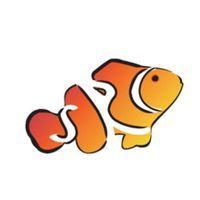
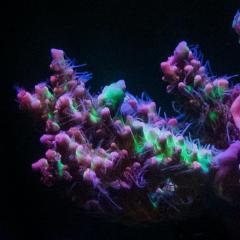
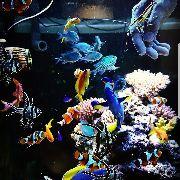
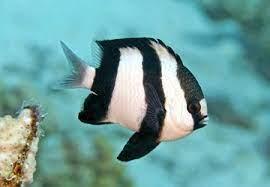
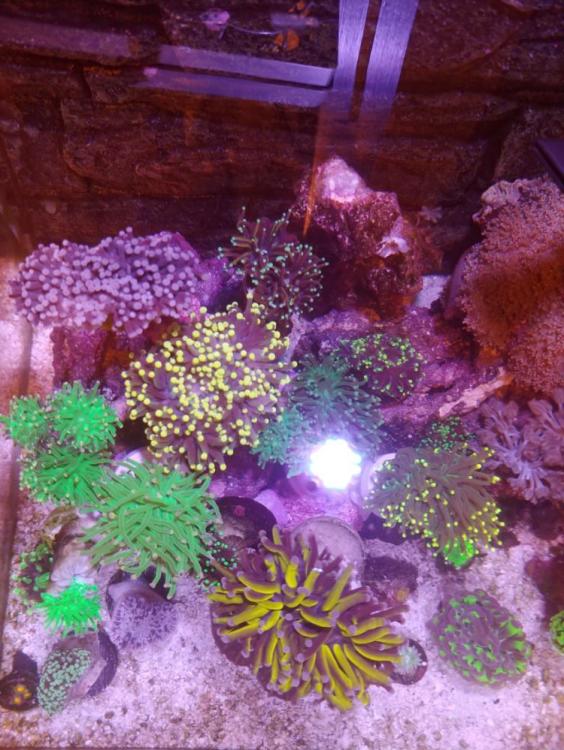
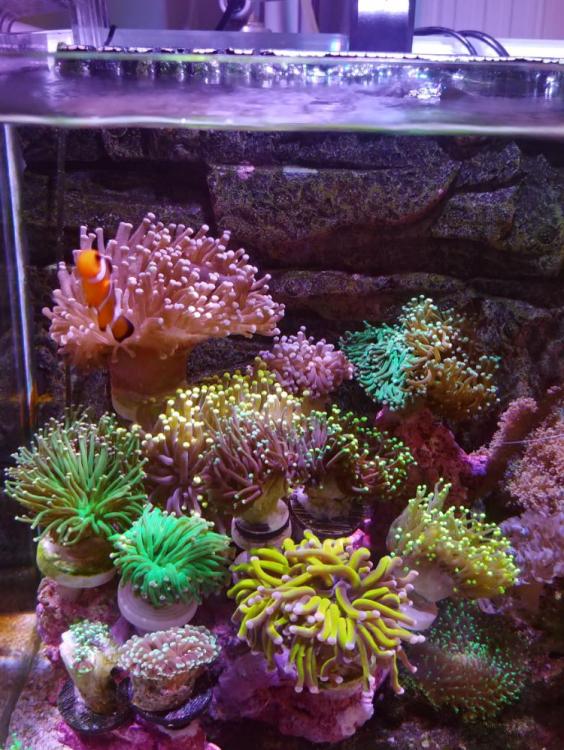
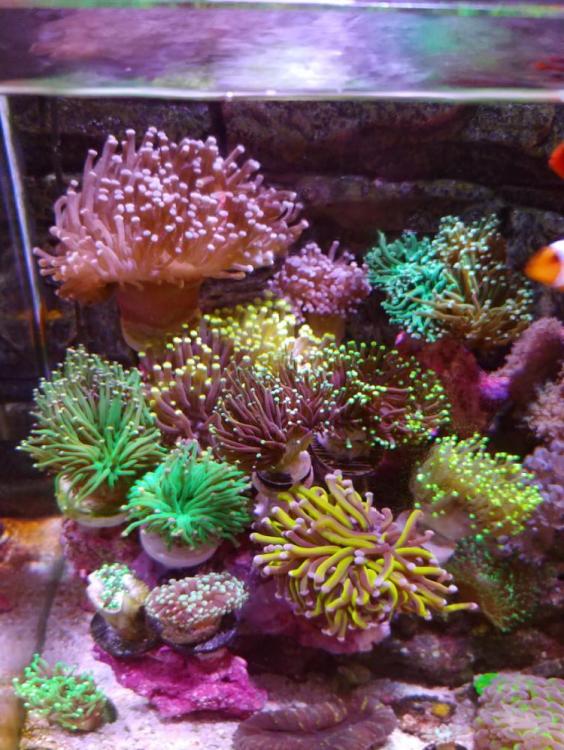

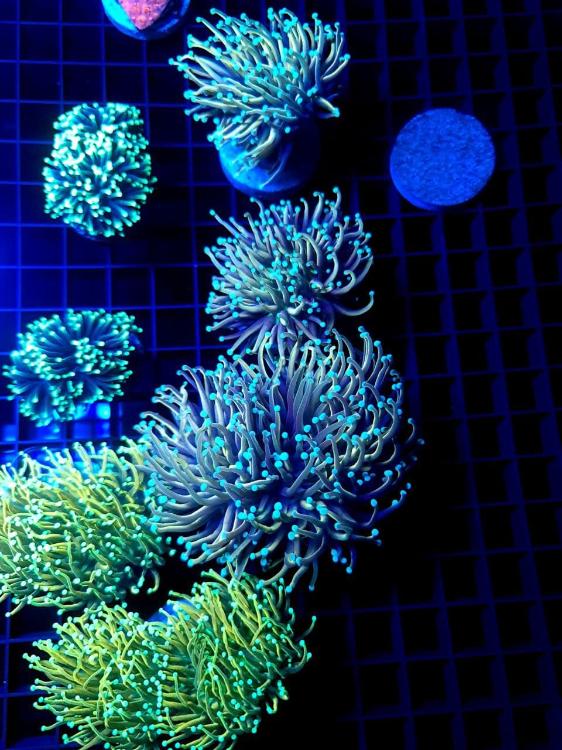
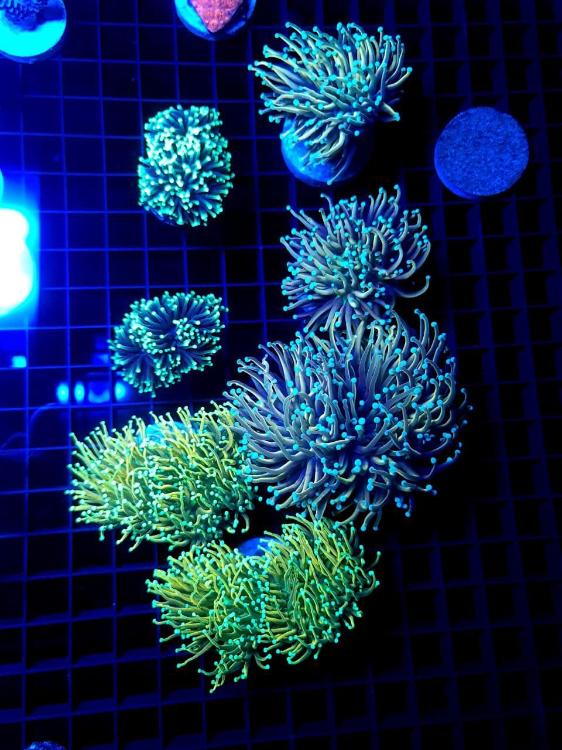
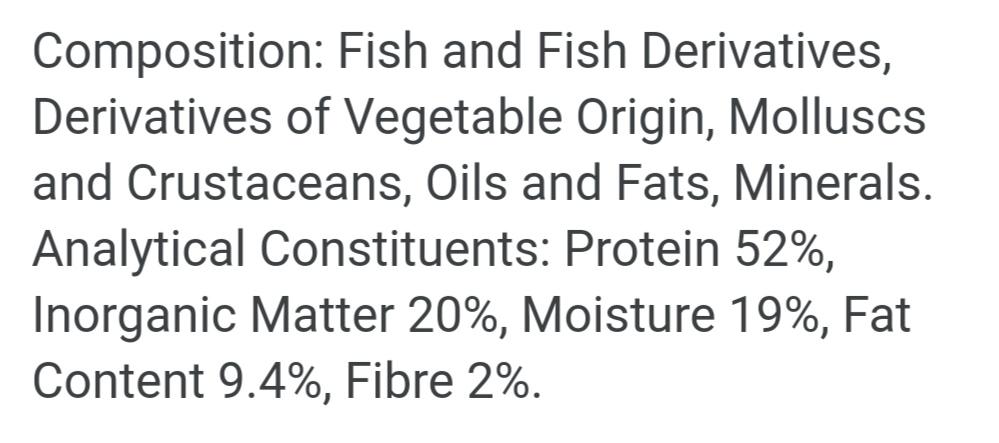
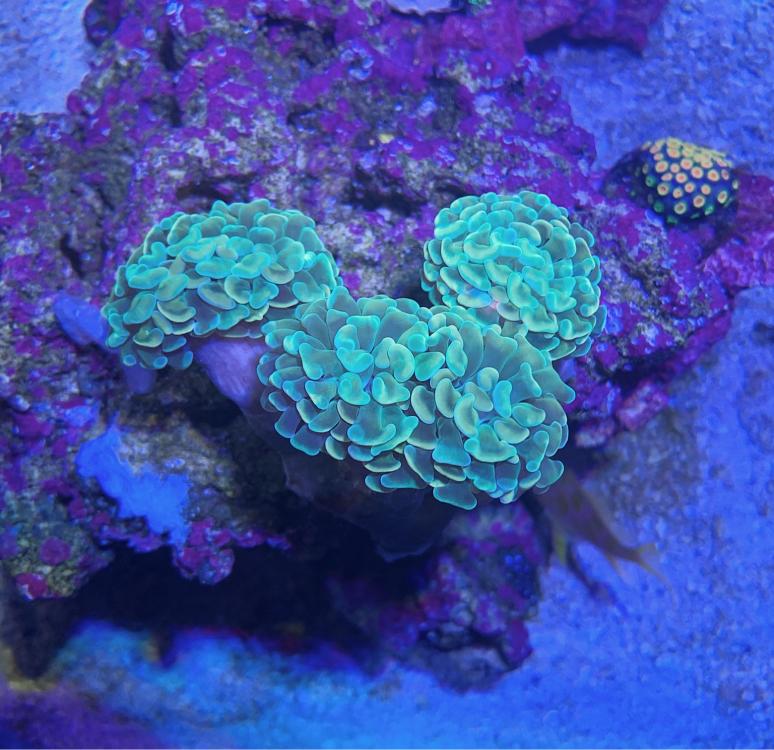

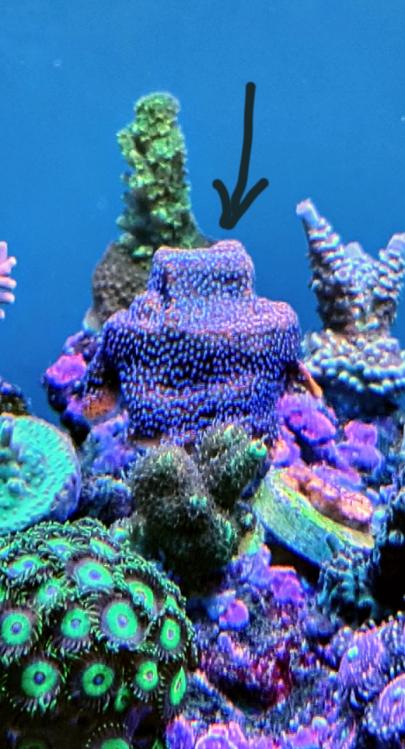
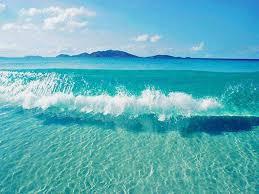
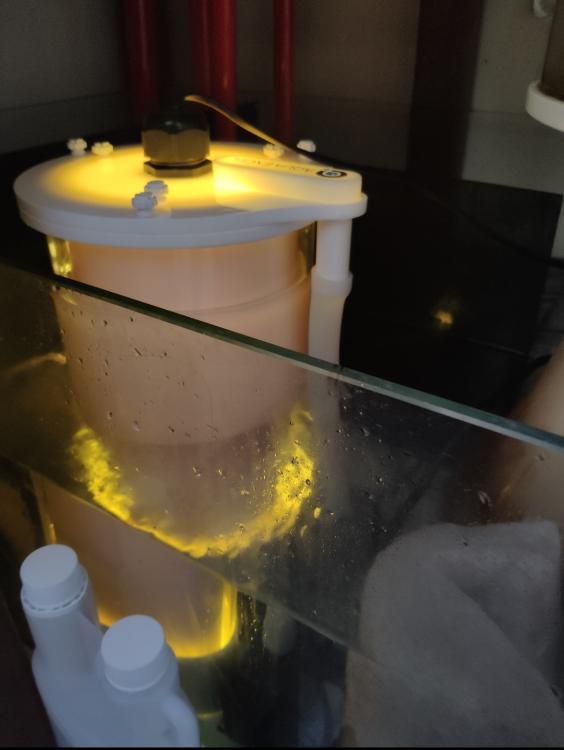
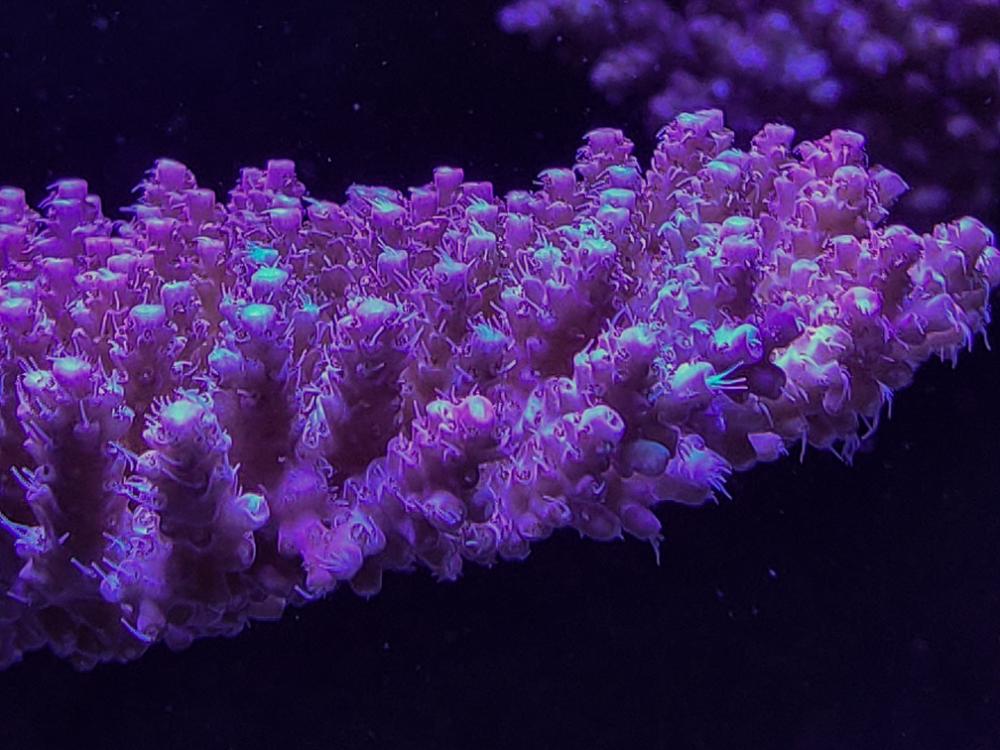
.thumb.jpg.57c2e34da3fe90fcdb8e11c6a93f46a9.jpg)
.jpg.82c6ddbd66086b9149104147fc91351c.jpg)
.jpg.8bb9208e245412ee256a7a2f74f7f09d.jpg)
.jpg.38c00cca93708e5a67b3f8fea4e964ed.jpg)
.jpg.d11e3c05268fc323324cec16dbff7553.jpg)
.jpg.067944dd72234138c5e01aa82d098cc9.jpg)
.jpg.bea895f8412269851538d30a17e257c7.jpg)